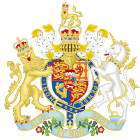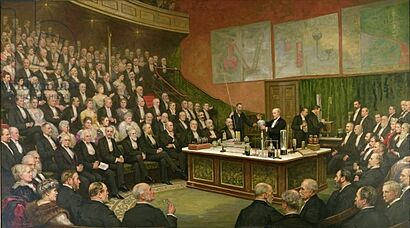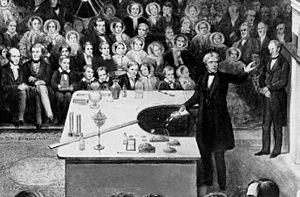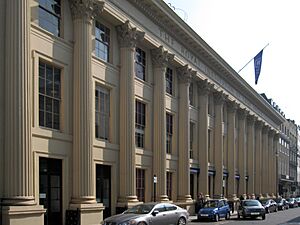Royal Institution facts for kids

The Royal Institution building on Albemarle Street, London, c. 1838
|
|
| Established | 1799 |
|---|---|
The Royal Institution of Great Britain (often called the Royal Institution or Ri) is a special place for science education and research. It is located in the City of Westminster, London. It was started in 1799 by important British scientists like Henry Cavendish. Its first president was George Finch.
The main goal of the Royal Institution was to share scientific knowledge. They wanted to help people use new inventions and improve everyday life. They did this through teaching, lectures, and experiments.
Much of the first money for the Institution came from a group called the Society for Bettering the Conditions and Improving the Comforts of the Poor. This group was guided by Sir Thomas Bernard, 3rd Baronet and Sir Benjamin Thompson. Since it began, the Royal Institution has been at 21 Albemarle Street in Mayfair. It received its official Royal Charter in 1800.
History of the Royal Institution
The Royal Institution started because Sir Benjamin Thompson (also known as Count Rumford) had an idea. He wanted to create a public place in London. This place would share knowledge about useful inventions. It would also teach how to use science in daily life. This would be done through lectures and experiments.
Founding the Institution
Rumford's idea led to a meeting on March 7, 1799. This meeting happened at the home of Joseph Banks, who was then president of the Royal Society. The Royal Society is an older science group. A few days later, on March 9, the first managers of the Institution met.
In June 1799, George Finch, 9th Earl of Winchilsea was chosen as the first president. In July, the society bought the building at 21 Albemarle Street. This building has been its home ever since. They immediately started fixing up the building. They made sure it had good spaces for meetings, offices, and science labs.
The first Professor and Public Lecturer was Dr Thomas Garnett. Rumford brought him from the Andersonian Institute in Glasgow in October 1799.
Early Lectures and Royal Charter
The main lecture hall is very famous. It has steep seats and is known for the Christmas lectures. This hall was finished in 1800. In the same year, the Institution received its royal charter from George III.
The lecture hall was used right away. Dr. Garnett gave the first lecture there in March 1800.
| Royal Institution of Great Britain Act 1810 | |
|---|---|
| Act of Parliament | |

|
|
| Long title | An Act for enlarging the Powers granted by His Majesty to the Royal Institution of Great Britain, and for extending and more effectually promoting the Objects thereof. |
| Citation | 50 Geo. 3. c. li |
| Dates | |
| Royal assent | 18 April 1810 |
| Text of statute as originally enacted | |
The Royal Institution has always helped people learn about science. They do this through many lectures. The most famous are the annual Royal Institution Christmas Lectures. Michael Faraday started these in 1825.
Dr. Garnett's first lectures were very popular. But his salary was not increased. He was also not allowed to work as a doctor. Humphry Davy was hired as his assistant, so Garnett left. Humphry Davy became even more successful. His assistant and later successor, Michael Faraday, was also a huge success.
Important Scientific Discoveries
The Royal Institution has played a key role in science. Many famous scientists have worked there. These include Sir Humphry Davy, who found sodium and potassium. Michael Faraday, James Dewar, and Sir William Henry Bragg also worked there. Sir William Lawrence Bragg and his father won the Nobel Prize for Physics. They worked on x-ray diffraction, which helps us see the structure of crystals.
In the 1800s, Michael Faraday did much research at the Royal Institution. His work helped us understand and use electricity. In total, fifteen scientists linked to the Royal Institution have won Nobel Prizes. Ten chemical elements, including sodium, were found there. The electric generator was also invented at the Institution. Much early work on the atomic structure of crystals happened there too.
A major supporter of the Royal Institution was John Fuller. He gave over £10,000 to the Institution. He also created two special professorships. Michael Faraday was the first Fullerian Professor of Chemistry. Today, these titles are no longer used.
Nobel Prize Winners
- John William Strutt (Lord Rayleigh) (1842–1919): Physics 1904 for finding argon.
- Joseph John Thomson (1856–1940): Physics 1906 for studying electricity in gases.
- Ernest Rutherford (1871–1937): Chemistry 1908 for work on radioactive substances.
- William Lawrence Bragg (1890–1971): Physics 1915 with WH Bragg, for finding crystal structures using X-rays.
- William Henry Bragg (1862–1942): Physics 1915 with WL Bragg, for finding crystal structures using X-rays.
- Charles Scott Sherrington (1857–1952): Medicine 1932 with Edgar Adrian, for discovering how neurons work.
- Henry Hallett Dale (1875–1968): Medicine 1936 with Otto Loewi, for work on nerve signals.
- Peter Brian Medawar (1915–1987): Medicine 1960 for making permanent skin grafts.
- John Cowdery Kendrew (1917–1997): Chemistry 1962 with Perutz, for finding the structures of haemoglobin and myoglobin.
- Max Ferdinand Perutz (1914–2002): Chemistry 1962 with Kendrew, for finding the structures of haemoglobin and myoglobin.
- Andrew Fielding Huxley (1917–2012): Medicine 1963 for explaining how nerves send electrical signals.
- Dorothy Crowfoot Hodgkin (1910–1994): Chemistry 1964 for finding the structure of important substances like vitamin B12.
- George Porter (1920–2002): Chemistry 1967 for work on light-triggered chemical reactions.
- Antony Hewish (1924–2021): Physics 1974 for finding pulsars.
- Sir John Gurdon (1933–): Medicine 2012 with Shinya Yamanaka, for showing mature cells can become stem cells.
Chemical Elements Discovered
- Potassium – Found by Humphry Davy in 1807 using electricity.
- Sodium – Humphry Davy first found sodium in 1807 from melted sodium hydroxide.
- Barium – Found by Humphry Davy in 1808 using electricity on melted barium salts.
- Boron – Discovered by Humphry Davy in 1808. He used electricity to make a brown powder. He had enough to know it was an element.
- Calcium – Found by Humphry Davy in 1808 from a mix of lime and mercury oxide using electricity.
- Chlorine – Found in 1774, but thought to be a compound. Humphry Davy named it chlorine in 1810 and said it was an element.
- Magnesium – First made and found in 1808 by Humphry Davy using electricity.
- Strontium – Known in mineral form, but found as an element in 1808 by Humphry Davy.
- Iodine – Discovered by Bernard Courtois in 1811. Humphry Davy later said it was a new element.
- Argon – Discovered in 1894 by Lord Rayleigh and William Ramsay.
Past Leaders of the Royal Institution
Past Presidents
Since 1799, the Royal Institution has had fifteen presidents and one acting president.
- 1799 – George Finch, 9th Earl of Winchilsea
- 1813 – George John Spencer, 2nd Earl Spencer
- 1825 – Thomas Pelham, 2nd Earl of Chichester
- 1827 – Edward Adolphus Seymour, 11th Duke of Somerset
- 1842 – Algernon Percy, 4th Duke of Northumberland
- 1865 – Sir Henry Holland, 1st Baronet
- 1873 – Algernon George Percy, 6th Duke of Northumberland
- 1899 – Henry George Percy, 7th Duke of Northumberland
- 1918 – Alan Ian Percy, 8th Duke of Northumberland
- 1930 – Lord Eustace Percy
- 1945 – Robert John Strutt, 4th Baron Rayleigh
- 1948 – John Theodore Cuthbert Moore-Brabazon, 1st Baron Brabazon of Tara
- 1963 – Alexander Fleck, 1st Baron Fleck
- 1968 – William Wellclose Davis (acting)
- 1969 – Harold Roxbee Cox, Baron Kings Norton
- 1976 – Prince Edward, Duke of Kent
Past Directors
The main leader of the Royal Institution has had different titles over time. These include Director of the Laboratory and Director of the Davy-Faraday Research Laboratory. The position of Director was removed in 2010. This happened after Susan Greenfield left the role.
The position was brought back in April 2017 with Sarah Harper. She resigned in September 2017. The current director is Katherine Mathieson.
Changes in Leadership
From 1998 to 2010, Baroness Susan Greenfield was the director. Her position was removed because it was "no longer affordable." The Royal Institution faced money problems. This was after a large building project led by Greenfield. The project cost £22 million and included updating the building. It also added a restaurant and bar. The project ended up £3 million in debt. Baroness Greenfield later decided not to pursue her case.
The Royal Institution said it would keep doing its main work. This would be under the guidance of its chief executive and a team of talented leaders.
The Royal Institution Today
Today, the Royal Institution still aims to "share science for the common purposes of life." Anyone can become a member. There are no special academic requirements. You just pay a yearly fee.
The Institution's patrons and trustees include:
- Patron: Charles III
- President: The Duke of Kent
- Honorary Vice-President: Sir John Ritblat
- Chairman: Sir Richard Catlow
- Board of Trustees (current): Sophie Forgan, Simon Godwin, Kate Hamilton, Suze Kundu, Renato Lulia, the Baroness Morris of Yardley, Vincent Nobel, Christopher Potter, Angela Seddon, Jack Stilgoe, Harriet Wallace, Allison Wollard
In December 2021, Katherine Mathieson became the Director. In July 2018, the Institution announced a new five-year plan. This plan aims to double the charity's size. It includes new research and a new national science club. It also plans for public discussions on science policy. A new Research Centre for Science and Culture will study how science and culture are connected.
The Institution's grand building has been made much larger since 1799. It is a Grade I listed building, meaning it is very important. The last big update to the building was in 2008. This £22 million project aimed to create a "science salon" for the public. Besides the famous Lecture Theatre, the building has many event rooms. It also has modern research facilities and a public café.
In 2013, the Royal Institution received a large donation of £4.4 million. By January 2016, the Institution was debt-free.
The Institution (now called 'Ri') has many public science programs. It also has programs for schools. They hold over one hundred events each year on many different topics. The Christmas Lectures are still held today. These are three televised lectures for children. The Friday Evening Discourses are monthly lectures by famous scientists. Each one lasts exactly one hour, a tradition started by Faraday.
Tickets for the Christmas Lectures are chosen by a ballot for members. But all other events are open to everyone. Members get discounts or free tickets. Many events are held at Albemarle Street and other places around the country.
Scientific research continues at the Davy-Faraday Research Laboratory (DFRL). This lab is known as one of the UK's top labs in nano-science.
In May 2015, the Royal Institution hosted the unveiling of the Santara Computer. This computer was created by Dr Andrew Deonarine.
In November 2015, a new membership plan started. The old "Fellows of the Ri" group was ended. New groups include Member, Under 26, and Ri Young Member. Adult Members can vote and use "MRi" after their names. A Patrons' scheme was also started.
In December 2011, the Royal Institution launched the Ri Channel. This website showed science videos and old content from the Royal Institution. This included past Christmas Lectures. The Ri Channel was archived in late 2017. Now, most Ri videos are on YouTube. Past Christmas Lectures are on the Ri's website. In early 2018, the Ri started uploading all past Christmas Lectures that were not already online.
The Royal Institution building is now also used as an office building. It hosts conferences, weddings, and other events to help pay its costs. In 2015, it sold some of its old manuscripts to raise money. Since 2021, researchers from the London Institute for Mathematical Sciences have rented rooms on the second floor. These rooms were once where Michael Faraday lived. They now do research in theoretical physics and mathematics there.
Faraday Museum
In 1973, the Royal Institution opened the Faraday Museum. This museum is all about Michael Faraday. It is in the main building on Albemarle Street. It is open to the public during weekday office hours. The most exciting part of the museum is Faraday's actual laboratory from the 1850s. It is not a copy. Right across from this lab is a modern nanotechnology lab. Other exhibits show the discoveries, people, and activities of the Royal Institution.
See also
 In Spanish: Royal Institution para niños
In Spanish: Royal Institution para niños
- British Association for the Advancement of Science
- Directors of the Royal Institution
- Gresham College
- Hakluyt Society
- History of science
- Learned societies
- London Institute for Mathematical Sciences
- Royal Institution Christmas Lectures
- Royal Institution of Australia
- Royal Institution of Cornwall
- Royal Institution of South Wales
- Liverpool Royal Institution
- Royal Manchester Institution
- Royal Society
- Science Media Centre
- Science outreach






